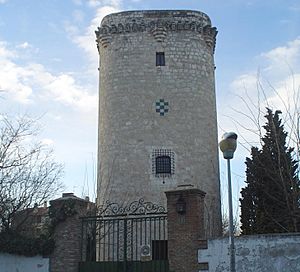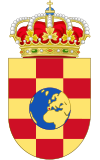Pinto, Madrid facts for kids
Quick facts for kids
Pinto
|
|||
|---|---|---|---|
 |
|||
|
|||
| Country | Spain | ||
| Region | Community of Madrid | ||
| Area | |||
| • Total | 62.7 km2 (24.2 sq mi) | ||
| Elevation | 604 m (1,982 ft) | ||
| Population | |||
| • Total | 51,541 | ||
| • Density | 822.0/km2 (2,129.0/sq mi) | ||
| Demonym(s) | Pinteños | ||
| Time zone | UTC+1 (CET) | ||
| • Summer (DST) | UTC+2 (CEST) | ||
| Website | www.ayto-pinto.es | ||
Pinto is a town in the Community of Madrid, Spain. It is located in the middle of the Iberian Peninsula. Pinto is about 20 kilometers (12 miles) south of Madrid. The town sits at an elevation of 604 meters (1,982 feet) above sea level.
Pinto covers an area of 62.7 square kilometers (24.2 square miles). In 2018, about 51,541 people lived there. The town is known for its historic towers, like the Torre de Pinto and the Éboli Tower. The Éboli Tower is a 14th-century building that was once used as a prison for important people.
Contents
What's in a Name?
The name "Pinto" might come from a Latin word. This word is pinctus, which means 'tincted' or 'colored'.
A Look Back in Time
Pinto has an interesting history. In the Middle Ages, there was a disagreement about the border between the lands of Segovia and Madrid. In 1239, a decision was made. Pinto became a small village, or hamlet, that belonged to Madrid. It was located near the area of Valdemoro.
Later, in 1331, Pinto was separated from Madrid's control. It was given to a person named Martín Fernández de Toledo. However, this decision was quickly changed in 1332. Pinto went back to being part of Madrid.
In 1350, Pinto became a special domain again. King Peter I gave the place to Íñigo López de Orozco. Even after this, Madrid continued to claim Pinto for many years.
Pinto's Symbols
Pinto has its own special coat of arms. A coat of arms is a design that represents a town or family.
Checkered with fifteen squares, eight of gold and seven of red. On top of this is a blue globe with gold continents. A red dot marks the center of the Iberian Peninsula. A Spanish royal crown sits at the very top.
Where is Pinto?
Location and Landscape

Pinto is located on a typical Castilian plateau. This means it has a flat, elevated landscape. Because it is close to Madrid, the town has grown a lot.
Two important streams flow through Pinto. The Arroyo de los Prados was first used for farming in 1967. The Arroyo Culebro also runs through the village. It forms the border between Pinto and the nearby town of Getafe. Sometimes, the Arroyo de los Prados can cause flooding in the area.
In the southwest part of Pinto, there is a special wetland area called Los Estragales. This is the last wetland left in the municipality. It is a home for many birds, with over 130 different types identified there.
Neighboring Towns
Pinto shares its borders with several other towns:
- North: Getafe
- South: Torrejón de Velasco and Valdemoro
- East: San Martín de la Vega
- West: Parla and Fuenlabrada
Climate
Pinto has a Mediterranean climate. This means it has very hot summers. Temperatures can reach up to 40 °C (104 °F). Winters are cold, and temperatures can drop below 0 °C (32 °F).
There isn't much rain in Pinto. The town gets about 450 mm (18 inches) of rain each year. The rainiest seasons are autumn and spring. Snowfalls used to be common, but now they happen very rarely.
How Many People Live in Pinto?
The study of how populations change is called demography. According to the 2018 census, the total population of Pinto was 51,541 people.
| 1889 | 1900 | 1920 | 1930 | 1950 | 1960 | 1970 | 1975 | 1982 | 1990 | 2000 | 2005 | 2006 | 2009 | 2010 | 2014 | 2015 | 2017 |
|---|---|---|---|---|---|---|---|---|---|---|---|---|---|---|---|---|---|
| 312 | 1,048 | 7,987 | 8,695 | 9,341 | 15,603 | 16,980 | 17,053 | 22,503 | 26,902 | 28,726 | 37,559 | 39,432 | 43,501 | 44,524 | 47,594 | 49,565 | 50,442 |
Places to See in Pinto

Pinto has several interesting places to visit:
- Ermita de San Antón (Saint Anthony Abbot hermitage) — This small church was rebuilt in the 1800s.
- Ermita del Cristo (Christ hermitage) — Inside this hermitage, there is a statue of a crucified Christ. Many people visit it.
- Iglesia parroquial de Santo Domingo de Silos (Parish of Saint Dominic of Silos) — This is Pinto's main church.
- Torre de Eboli (Tower of Eboli) — This famous tower was used as a prison. The Princess of Eboli was held here.
- Centro Cultural Infanta Cristina — This building was once thought to have hosted the Catholic Monarchs. However, studies have shown this is not true.
- Centro Municipal de Cultura (Local Culture Center) — A place for cultural events and activities.
- Teatro Municipal Francisco Rabal (Francisco Rabal Town Theatre) — The town's theater, named after a famous actor.
- Parque Juan Carlos I (Juan Carlos I Park) — A large park where people can relax and play.
Famous People from Pinto
Pinto is the hometown of some well-known individuals:
- Alberto Contador — A famous cyclist who won the Tour de France twice, the Giro d'Italia twice, and the Vuelta a España three times.
- Sandra Aguilar — An Olympic medalist in rhythmic gymnastics.
See also
 In Spanish: Pinto (Madrid) para niños
In Spanish: Pinto (Madrid) para niños




